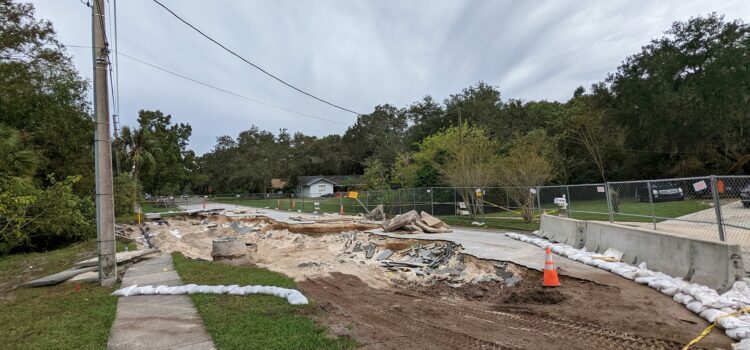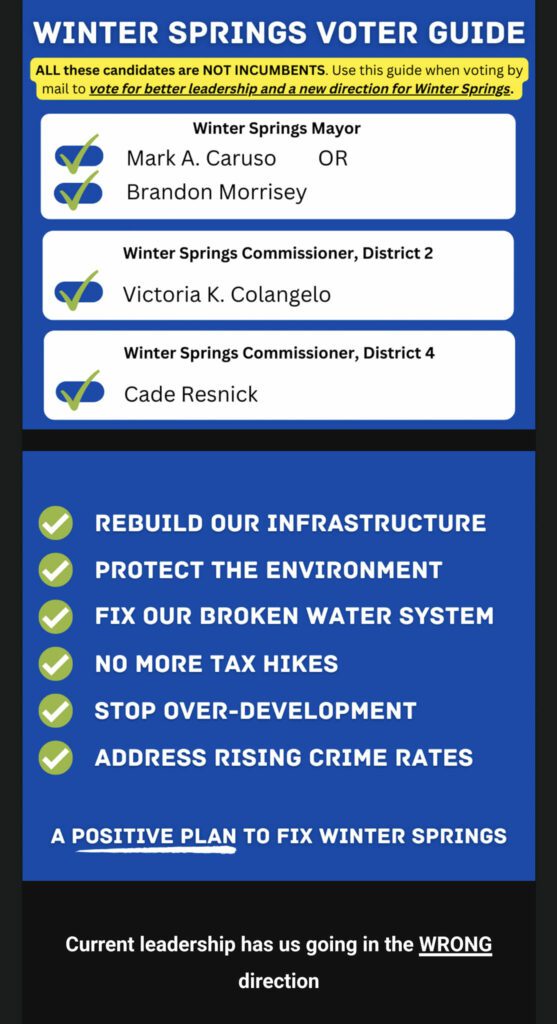By: Martin E. Comas, Orlando Sentinel
https://www.orlandosentinel.com/news/seminole-county/os-ne-politics-2022-winter-springs-commission-20221028-ypnu4b2czjhzfj7j52fll3346m-story.html
The city’s aging wastewater system, apartments, crime and hopes for a new library are the top campaign issues among the seven candidates vying for the mayor’s seat and two spots on the Winter Springs commission in the Nov. 8 city elections.
Tucked in the center of Seminole County, Winter Springs is mostly a residential community with a population of roughly 38,000 residents, according to the U.S. Census Bureau. The median household income, nearly $77,000 a year, is more than 25% higher than the rest of Central Florida.
Winter Springs’ five commissioners and mayor are non-partisan and serve four-year terms. They are elected citywide, however, they must live within their individual districts.
Mayor
Kevin McCann was named mayor by commissioners in April 2021 after Charles Lacey, who served in that role for about a decade, resigned amid policy differences with several other commissioners.
Winter Springs this year launched its largest and costliest infrastructure project in its history: Replacing its aging wastewater treatment system — including four plants — at an estimated cost of over $70 million. Construction is expected to start next year and be completed by the end of 2024.
“Our wastewater systems are in desperate need of repair,” said McCann, a restaurant and hotel manager. “The plants are in such dire shape. So we’re going to build brand new plants with new technology that will make them easier to maintain and have a lower cost to operate.”
In 2019, Winter Springs contracted with Veolia Water North America LLC to manage the city’s water, wastewater, stormwater and reclaimed water services after sewage spills and high levels of chlorine in the potable water.
In recent years, Winter Springs residents have complained about the increasing number of high-story apartment buildings rising along the State Road 434 corridor. But McCann said he and other commissioners “have no appetite” for approving additional apartments in the city.
McCann’s opponent, Mark Caruso, is a former New York City police officer and retired sergeant with the Florida Department of Corrections.
He said if elected he would move the commission to terminate the city’s contract with Veolia.
“I would like to see us bring back our public works department,” he said. “That would be a better benefit for the city because the employees would be people that live here. It seems that Veolia is just in it for the money and not for the city’s benefit.”
Caruso said he’s concerned about a recent uptick in petty thefts and burglaries. He would hire more police officers and raise officer salaries to prevent them from looking for better-paying jobs at other law enforcement agencies.
“We’re understaffed,” he said. “I want to make salaries very competitive compared to other cities.”
A lifelong Winter Springs resident, Brandon Morrisey feels it’s time for the city “to stop kicking the water-treatment-plant can down the road” and move forward at a quicker pace on the improvements.
He wants to spearhead a task force “to find a cost-effective, expedited way to update the plant before our previous generations’ mistakes become a catastrophe for the future.”
Morrisey, a Realtor, said he started attending city commission meeting “as a hobby.” But he said he soon became concerned after city leaders often discussed problems with the city’s water and wastewater treatment plants.
“So I decided to throw my hat in the ring and run for mayor,” he said.
Morrisey said much of the flooding that occurred in Winter Springs after Hurricane Ian could have been alleviated if the city had annually dredged the creeks, including Gee Greek, which overflowed after the storm and flooded homes.
“If it is maintained properly, we still would’ve had some flooding but it wouldn’t have been as substantial,” Morrisey said.
Morrisey proposes lightning alarms be installed in parks after a lightning strike in August killed Nicole Tedesco and injured her 10-year-old at Trotwood Park in Winter Springs.
“Not only would this alert system have saved a life, but it will save countless others in the future,” according to his campaign website.
District 2
Incumbent Commissioner Kevin Cannon is running for his third and final term after first being elected in 2014.
“The sewer plants are 50 years old, and they’re falling apart,” he said in support of the infrastructure project.
Cannon said the city hired Veolia because of their staff’s extensive knowledge. He noted that it’s difficult for smaller cities, including Winter Springs, to hire and retain experienced public works directors and employees because many seek jobs at larger municipalities.
“Veolia is an international company,” he said. “They bring the experience, and the ability to make the plants run. … There’s a huge advantage to it.”
Cannon, an attorney, said the city does not need any more apartments or storage facilities.
“There’s no more place for apartments in the city,” he said. “What we do need is retail, commercial and doctors’ offices and grocery stores and the like, along the [State Road] 434 corridor. … We have enough apartments.”
His opponent, Victoria Colangelo, said the city is underestimating the final price for replacing the wastewater treatment plants. She fears it may eventually cost double, or about $140 million, that the city estimates. And residents will end up paying for it through their utility bills.
“They’re just not being transparent,” she said about city staff and commissioners. “They say it’s going to be done in two years. But that’s a lofty goal.”
In the meantime, she argues the city is not working on an adequate plan to keep the current aging wastewater systems running properly. She noted recent wastewater spills as examples.
“It’s a huge concern,” Colangelo, owner of the Mitigation Banking Group, said. “I would rewrite the [city’s] contract with Veolia.”
Colangelo said was spurred to run after seeing so many wooded properties being destroyed for new apartment complexes.
“Our infrastructure is crumbling, and we can’t add more population with apartments,” she said. “We need to preserve trees and open space. They say we’re the city of trees, but there’s a lot of tree destruction.”
District 4
Commissioner TiAnna Hale, who was first elected in 2018, is seeking her second term. One of her main priorities is working with Seminole County to build a library branch in Winter Springs.
A recent consultant’s report commissioned by Seminole this year blasted the county’s library system as being woefully underfunded and needing at least three more branch libraries over the next two decades to meet population growth.
Hale said it’s time the city brought back plans and funds it set aside during the COVID-19 pandemic for a new events center near Lake Jesup and now use those for a new library.
“If we could work together with the county, we could come up with this amazing collaboration to build an events center and library together,” she said.
Hale, a full-time caregiver for her husband, an Army sergeant who was injured in Iraq, was pleased the county recently completed a nearly mile-long gap on the Cross Seminole Trail in Winter Springs that has long frustrated bicyclists and walkers.
“It was a dead zone in the trail through Winter Springs because of that,” she said. “It makes for a healthy community.”
Her opponent, Cade Resnick, served on the Winter Springs Commission from 2010 until 2018, when he ran unsuccessfully for the Seminole County School Board.
A teacher for Florida Virtual School, Resnick said he was spurred to run for his old seat after a faulty pipe from a city wastewater treatment plant spilled water in early 2021 into a retention pond near the Highlands neighborhood, killing scores of fish and causing a rotting smell throughout the area.
City officials, at the time, posted a notice on Facebook saying a malfunctioning valve caused the spill and the dead fish were cleaned up.
“It’s not just about the lake, but everything going wrong,” Resnick said. “They [current commissioners] don’t want to take the blame.”
Resnick blamed the city for not annually dredging Gee Creek, which overflowed after Hurricane Ian last month and contributed to widespread flooding at the Hacienda Village, a 55-plus manufactured home community, where residents endured days without power and boil water notices after multiple water main breaks.
“This commission is not being active,” Resnick said. “Flooding occurred because the city wasn’t adequately prepared. Instead of saying, ‘We have a lot of work to do,’ they say, ‘It’s not our fault. It was a big storm.’”



















